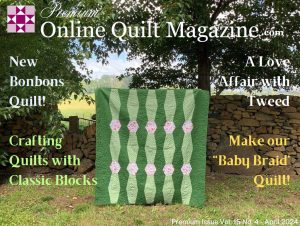

How To Make A Patchwork Top
July 13, 2023

Hi!
I hope you’ve had a good week. I’m a little late with this week’s post, but it’s been all “Go” with our Quilter’s Advent Calendar Earlybird Sale, and I haven’t had time to sit down and get this written out properly until now. Today, I wanted to share a process with you on how to make a patchwork top.
In between making quilts, and Advent Calendar projects, I’ve become a little obsessed with some of the quilted and patchworked clothing that keeps popping up on my social media feeds. I love that it is different, and each piece is unique, and that you can really make it your own. This is my take on a top I made this week, just to see how it would work. I will be honest – some of it will be ‘do as I say, not as I do’, but overall, making a patchwork top was really fun, and it’s something I’ll be definitely making again.
How to Make A Patchwork Top

The design idea for my top was an oversized simple top, that I could wear by itself, or with a long sleeved t-shirt underneath. It’s winter here, so I decided on a nice warm knit fabrics top. In the spirit of full disclosure, this was maybe not the best choice of fabric to start with, as it’s super stretchy, but it still gave a good result.

I based my top on a jumper/sweater that I already own. It’s big and baggy with a roll down cowl neck. I liked the width, and decided to make it a bit longer for this project.

First, make a basic pattern. I know this is an oversized top, but having a basic paper pattern to work from saved me from all sorts of sizing dramas.
To make the pattern for my patchwork top, I simply folded my sweater in half and traced around it.

Like so! I added about 5 inches to the bottom edge, and reshaped the neckline.

Then, put that pattern half on another sheet of paper, and cut out the pattern shape from both sheets at the same time, joining the sheets together in the middle. (I did it this way as I didn’t have paper large enough for the whole top in one go).

For this patchwork top, I went to my local thrift store and found four different knit tops. Use fabric if you have it, but I wanted to re-purpose these old tops instead.

Now for the fun part – cut them up into usable pieces!
Cut off the bands, and the seams, and try to keep the largest pieces of plain fabric that you can.

Initially, I was going to use these grey armholes for the sleeves on my patchwork top, (as these lovely sewn bands meant that I could avoid having to hem the sleeves), but I went with the red in the end, as they were a bit wider.

Then I got looking at the red top neckline, and as it was about the right shape that I was after, I decided to use it as is too. (Again, to save on having to hem the neckline, and this had a cute little rolled edge.)
With those basics sorted out, it’s really just a matter of adding pieces and patches to cover the pattern.

The start of the front. I positioned the neck panel and the sleeves, and then cut pieces to fit. This improv, no-real-pattern-to-follow making is fun!!
I mixed and matched, and discovered I could use the wide band around the bottom of the pink cardigan for a feature vertical strip as well.

Now – if you have a serger / overlocker, then DEFINITELY use it for sewing the pieces together. As mine is well out of action, I sewed this patchwork top on my regular machine. It worked, but could be handled better next time I decide to use stretchy knit fabric.
If you’re using a regular machine to make yours too, sew the pieces together first, and use a generous (1/2 inch) seam allowance.

Then zig zag stitch the edges to stop fraying / raveling.

Then, on the right side, topstitch along the seam (1/4 inch in) to flatten the seam, and catch the seam allowance neatly behind one side.
I sewed all seams like this, and while it worked fine, some of the seams did stretch and get a bit wavy. I think I could steam iron them to get them back into shape, but I now think that a better option (for those without sergers) would have been to add a little strip of light-weight fusible interfacing to the edges on the wrong sides, to stabilise the edges and stop the stretch.

As far as patchworking – I worked in panels, so I only had a couple of full length seams to sew.

The finished front!

…and the back!
I used the same pattern for the back, and even left the front panel laid out too, so I could match up where the neckline and sleeves had to meet.

Both sides. I do like the different fabrics and that improv patchwork effect.

Finally, to put it together, I sewed the shoulder seams to join front and back, and then the sides and underarms to finish.

I trimmed to even up the lower edges, then zig zagged the edge, and folded up once to hem.
This patchwork top actually worked great, and aside from a few slightly wavy seams, it went together really easily. For my next one, I’m thinking linen might be the fabric of choice. Maybe I’ll add some printed feature fabric too.
My tips for that – if it’s a heavier weight linen / fabric, think about binding with edges with single fold bias binding, or alternatively, you could cut a facing for the neckline and just flip it to the inside and topstitch for a neat finish.
I do love the oversize, floppy and oh-so-comfortable style of this patchwork top, and I’ll be giving it a go again in a non-stretchy lighter weight fabric when we get to our summer. Who knows – I might even turn it into a simple dress!
That’s it from me for this week. Do give this a go, and see what you can create for yourself.
Enjoy your week!



Hi Jody maybe when sewing jersey knit fabrics especially when the knot is going in different directions a stretch stitch would be a better choice than a straight normal stitch OR maybe use some of those gorgeous decorative stitches that every DSM comes with nowadays? Not only would they stabilise the seams but make the seams a pretty unique item.
Hi Dawn,
That’s a great idea! I’m sewing on a very basic machine right now, but your suggestion would certainly help stop the stretch in the seams.